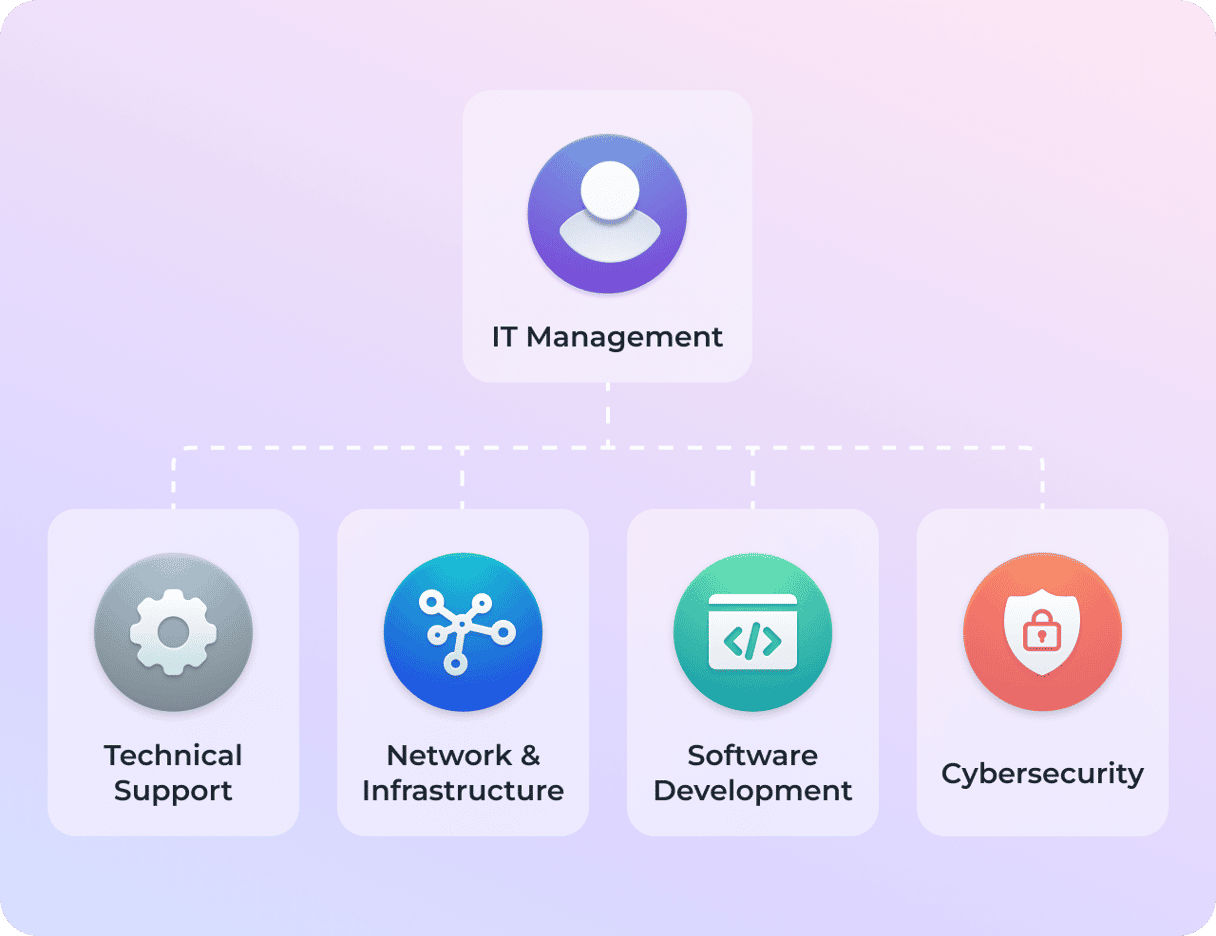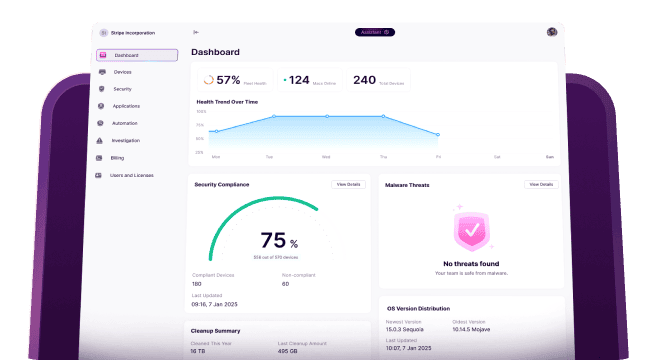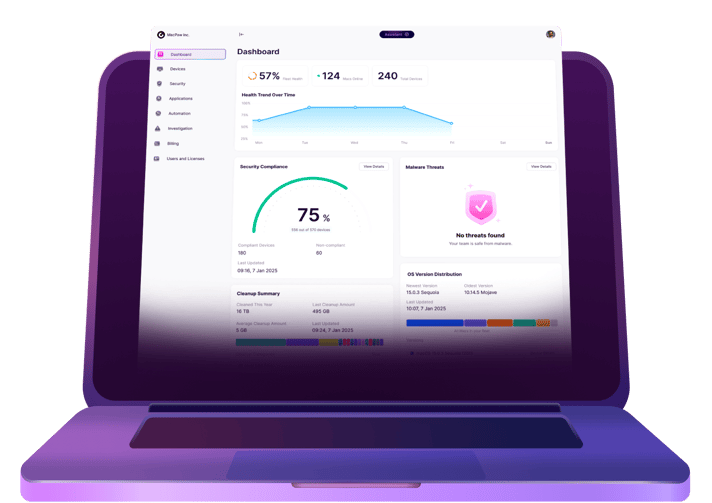Learning how to troubleshoot computers and servers is really only part of the job for an IT team member. Like any other enterprise department, it’s important to be aware of the structure and roles within your team. This helps everybody understand the chain of command and who is responsible for which tasks and allows things to run smoothly as well as facilitates better collaboration.
In this article, I’ll explain how a full IT department is structured, going into detail about the various roles and responsibilities. I will also provide some best practices to help you and your team stay on top of your game — always one step ahead.
What is an IT department?
It’s critical to have a basic understanding of what the IT department's responsibilities are. Most people just assume that IT is where you go when your email stops working, or you have some other similar issue. But, in reality, IT can encompass every piece of a company’s technology infrastructure — whether the equipment is only being used internally or is public facing that your customers will access as well.
The primary goal of your IT team is to make sure all of your company’s technology needs are being met. A proactive team will always be looking to make operations more efficient and secure for each line of business.
IT department structure and roles
Let’s take a look at the structure of an IT department. Obviously, this will vary based on your company's size and needs. You may not have every position filled, but it’s helpful to see what hats everybody should be wearing.

IT Management
- Chief Information Officer (CIO): Develops and oversees the company’s IT company.
- IT Director: Manages the overall IT department, overseeing IT projects and budgets.
- IT Manager: Supervises IT teams and implements IT policies.
Technical Support
- Help Desk Technician: Provides first-level support to end-users by troubleshooting hardware and software issues.
- Desktop Support Technician: Assists with hardware and software installation and maintenance.
Network and Infrastructure
- Network Administrator: Designs and maintains the company’s entire network infrastructure.
- Network Engineer: Optimizes network performance and ensures network security while troubleshooting any network-related issues.
- Systems Administrator: Manages and maintains the organization’s servers and other critical systems.
Software Development
- Software Developer: As you would correctly assume, they are responsible for developing software applications and systems.
- Quality Assurance Analyst: Before shipping or rolling out new software, these analysts test it to ensure it meets all quality requirements.
- DevOps Engineer: Collaborates with partners and vendors to make the development process more efficient through automation.
Cybersecurity
- Security Analyst: Monitors your entire infrastructure, looking for any suspicious activity and responding when incidents arise.
- Security Engineer: Designs the security policies that will better protect the company’s systems and data
- Chief Information Security Officer (CISO): Oversees the entire cybersecurity arm of the IT team. They develop and enforce the organization’s cybersecurity strategy across the entire infrastructure.
IT Department Best Practices
Now that you have a basic understanding of the various roles on an IT team, here are some best practices that will help your team function even better:
1. Align IT goals with business priorities
Everything that happens within your company should ladder up to supporting the business’s objectives. The same is true for your IT strategies. Whatever policies you implement should all be in support of helping the overall mission and vision.
2. Set up clear communication channels
Clear communication is a critical component of a successful team. That’s true for various teams within your IT department as well as for other departments in your company. If you can advocate for collaboration, you’ll be surprised at some of the results that come out of it.
3. Invest in team member growth
They say a good leader will be their staff’s floor and not their ceiling. If you’re able to provide your IT team with the opportunities they need to grow, whether on the job or through training and certifications.
4. Roll out ITIL (IT Infrastructure Library) practices
An IT Infrastructure Library can be an invaluable resource for your team. Fill it with how-to’s and best practices for your team to reference. All of it can help you deliver top-tier service consistently and efficiently.
5. Prioritize cybersecurity
Cybersecurity should always be your top priority. Ransomware and phishing attacks pose significant security threats that can compromise your critical data and lead to severe consequences for your business. Using reliable, centralized Mac maintenance software can help mitigate these cybersecurity risks. CleanMyMac Business protects your Mac fleet with always-on monitoring, enabling you to implement disk encryption and establish a password policy. Even if malware does infiltrate your system, detailed reports can provide more insights into the incident, allowing you to neutralize the threat before it causes any damage. Try it for free for 14 days.

6. Be flexible
We all know technology changes at a breakneck pace. Embrace agile principles that will help your team pivot as your business priorities change and adapt.
7. Monitor performance metrics
Set up and track key performance indicators (KPIs). They can help measure your team’s effectiveness and ascribe value to the services you’re providing to the company.
8. Automate repetitive tasks
Don’t let yourDon't get bogged down in redundant, day-to-day tasks. Automate easy and repetitive tasks to help reduce manual work and minimize the margin for human error.
9. Advocate for innovation
It’s important to encourage your team to think outside the box. Don’t let them get complacent or comfortable with doing things the way they’ve always been done. Foster a culture of innovation and let your team surprise you with the new ideas they’re able to come up with.
10. Plan for business continuity
As foolproof as we try to make everything, there are some things that are just out of our control. You should always have a comprehensive plan to ensure you’re able to get your IT infrastructure back up and running in the event of a disaster. Expect the unexpected, and you’ll be able to reduce downtime for your entire company.
Having even just a basic understanding of the roles within an IT department structure can set you up for better success. Even if you don’t have the personnel to fully flesh out a team like this, then you’re able to fill in the gaps and make your department that much stronger.
Knowing how to implement new systems or how to troubleshoot issues is only half of the responsibility of an IT team member. Being able to clearly communicate with others on your team can help foster a culture of collaboration. Exchanging ideas and bettering not just the IT department but the company at large. Together, you and your team can drive your company’s success in an increasingly competitive and technology-driven world.








